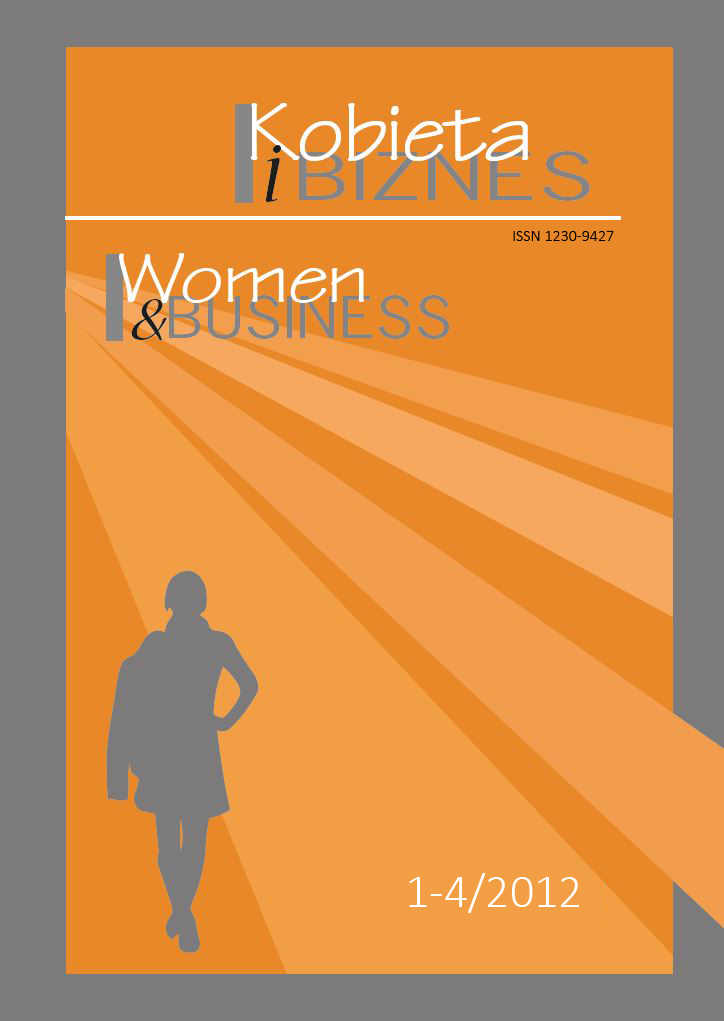Kobiety w zarządach firm : różnorodność vs. patriarchalny porządek
##plugins.themes.bootstrap3.article.main##
Abstrakt
Na przestrzeni ostatnich stu lat dokonały się dostrzegalne i korzystne dla kobiet zmiany związane z wyrównywaniem ich szans na rynku pracy. Dzięki ruchom feministycznym pierwszej i drugiej fali kobiety uzyskały prawo do edukacji i prawa wyborcze, dokonał się postęp w dostępie kobiet do rynku pracy, do biznesu i stanowisk kierowniczych. Dane dla Polski pokazują, że dzisiaj kobiety są lepiej wykształcone niż mężczyźni i mają kwalifikacje ku temu, by zajmować stanowiska kierownicze najwyższego szczebla - stawać się właścicielami firm lub sprawować funkcje prezesów i dyrektorów generalnych w charakterze pracownika najemnego. Jest coraz więcej badań dowodzących, że różnorodność ze względu na płeć jest korzystna dla firmy, bo generuje wyższą efektywność dzięki wyższej wydajności i większej kreatywności zróżnicowanych zespołów. W obliczu radykalnych zmian demograficznych, skutkujących mniejszą liczbą kolejnych generacji wkraczających na rynek pracy, bardzo istotne jest, żeby korzystać z potencjału coraz lepiej wykształconych kobiet i traktować je jako równorzędny (a nie podporządkowany) mężczyznom zasób siły roboczej. Patriarchat jako system społeczny, w którym kobiety pełnią role podrzędne wobec mężczyzn, wyczerpuje swoje znaczenie i przestaje mieć współcześnie rację bytu, tzn. nie służy rozwojowi społeczno- gospodarczemu i dobrobytowi społeczeństw. Zaczyna go zastępować partnerstwo kobiet i mężczyzn w pracy i rodzinie. Przeistaczanie się patriarchatu w partnerstwo jest procesem długotrwałym, więc żeby go przyspieszyć wprowadzane są rozwiązania w postaci kwot (określonego liczbowo udziału przedstawicieli każdej płci w polityce i biznesie), mające charakter działań tymczasowych - implementowanych na określony czas, żeby szybciej osiągniąć cel, jakim jest uzyskanie równowagi płci w gremiach decyzyjnych.
##plugins.themes.bootstrap3.article.details##
Autor (Autorzy) artykułu oświadcza, że przesłane opracowanie nie narusza praw autorskich osób trzecich. Wyraża zgodę na poddanie artykułu procedurze recenzji oraz dokonanie zmian redakcyjnych. Przenosi nieodpłatnie na Oficynę Wydawniczą SGH autorskie prawa majątkowe do utworu na polach eksploatacji wymienionych w art. 50 Ustawy z dnia 4 lutego 1994 r. o prawie autorskim i prawach pokrewnych – pod warunkiem, że praca została zaakceptowana do publikacji i opublikowana.
Oficyna Wydawnicza SGH posiada autorskie prawa majątkowe do wszystkich treści czasopisma. Zamieszczenie tekstu artykuły w repozytorium, na stronie domowej autora lub na innej stronie jest dozwolone o ile nie wiąże się z pozyskiwaniem korzyści majątkowych, a tekst wyposażony będzie w informacje źródłowe (w tym również tytuł, rok, numer i adres internetowy czasopisma).
Osoby zainteresowane komercyjnym wykorzystaniem zawartości czasopisma proszone są o kontakt z Redakcją.
Autor zgadza się na dalsze udostępnianie pracy wg wymagań licencji CC-BY-NC
Bibliografia
2. Adler R. (2001), Women in the Executive Suite Correlate to High Profits, www.equalpay.nu/docs/en/adler_web.pdf
3. BAEL (2012), Aktywność ekonomiczna ludności Polski, I kw. 2012, seria: Informacje i opracowania statystyczne, GUS, Warszawa.
4. Bengtsson M., Kock S. (2000), Coopetition' in Business Networks - to Cooperate and Compete Simultaneously, "Industrial Marketing Management" No. 29, http://crrm.u-3mrs.fr/web/ IMG/pdf/Coopetition_in_Business_Networks_to_Cooperate_ and_Compete_Simultaneously.pdf (dostęp 12.09.2012).
5. Boruta I. (1996), Równość kobiet i mężczyzn w pracy w świetle prawa wspólnoty europejskiej. Implikacje dla Polski, Wydawnictwa Uniwersytetu Łódzkiego, Łódź.
6. Carter N.M., Silva Ch. (2010), Udział kobiet w zarządzaniu: brak postępów, "Harvard Business Review Polska", kwiecień.
7. Catalyst Census (2010), Fortune 500 Women Board Directors, www.catalyst.org
8. Ciechomska M. (1996), Od matriarchatu do feminizmu, Wyd. Brama, Poznań.
9. Durska M. (2009), Zarządzanie różnorodnością: kluczowe pojęcia, "Kobieta i Biznes", nr 1-4, s. 8-12.
10. European Commission (2005), The Business Case for Diversity. Good Practices in the Workplace.
11. Directorate General for Employment, Social Affairs and Equal Opportunities, Luxembourg; http://ec.europa.eu/employment_ social/fundamental_rights/pdf/pubst/stud/busicase_en.pdf
12. European Commission (2008), Continuing the Diversity Journey- Business Practices, Perspectives and Benefits, Directorate General for Employment, Social Affairs and Equal Opportunities Luxembourg; http://ec.europa.eu/employment_social/ publications/booklets/fundamental_rights/pdf/ke7005617_ en.pdf
13. European Commission (2010), More women in senior positions. Key to economic stability and economic growth, Directorate General for Employment, Social Affairs and Equal Opportunities Luxembourg, January
14. Eurostat (2011), Employment by sex, age groups and nationality, 3rd quarter
15. Friedan B. (1963), The feminine mystigue, Norton, New York.
16. Hofstede G., Hofstede G.J. (2007), Kultury i organizacje, przekład M. Durska, PWE, wyd. II, Warszawa.
17. Ibarra H., Carter N.M., Silva Ch. (2010), Why Men Still Get More Promotions than Women, "Harvard Business Review", September 2010, http://www.mccarthymentoring.com/articles/ whymen.pdf (dostęp: 29.04.2012), s. 6.
18. Kandola R., Fullerton J. (1998), Managing the Mosaic: Diversity in Action, Institute of Personnel and Development, London.
19. Kirton G., Greene A.M. (2005), The Dynamics of Managing Diversity. A Critical Approach, Elsevier Butterworth-Heinemann, Oxford.
20. Kurzynowski A. (1979), Aktywizacja zawodowa kobiet zamężnych w Polsce Ludowej. Geneza - czynniki rozwoju - perspektywy, Książka i Wiedza, Warszawa.
21. Lisowska E. (2010), Kobiety w spółkach giełdowych i rentowność firmy, "Kobieta i Biznes", nr 1-4, s. 3-12.
22. Lisowska E. (2008), Równouprawnienie kobiet i mężczyzn w społeczeństwie, SGH, Warszawa.
23. Przewodnik dobrych praktyk. Firma Równych szans (2007), Gender Index, EQUAL, UNDP, Warszawa.
24. Rich A. (1976), Of woman born: Motherhood as experience and institution, Norton, New York.
25. Sękalska D. (1982), Kobieta wyzwolona, Krajowa Agencja Wydawnicza, Warszawa.
26. Sokół Z. (1995), Walka kobiet o wstęp na uniwersytety w Polsce, "Pełnym Głosem", nr 3, s. 81-91.
27. Siemieńska R. (1996), Kobiety: nowe wyzwania. Starcie przeszłości z teraźniejszością, Instytut Socjologii UW, Warszawa.
28. Slany K. (2011), Rodzina w refleksji feministyczno-genderowej, [w:] Gender w społeczeństwie polskim, red. K. Slana, J. Struzik, K. Wojnicka, Nomos, Kraków.
29. Ślęczka K (1999), Feminizm. Ideologie i koncepcje społeczne współczesnego feminizmu, Wyd. "Książnica", Katowice.
30. Thomas D.A., Ely R.J. (2005), Różnice mają znaczenie. Nowy paradygmat zarządzania różnorodnością, [w:] Kobiety i biznes, tłum. J. Krzemień-Rusche, E. Borówka, Wyd. Helion, Gliwice (wyd. oryg. Harvard Business Review on Women in Business, Harvard School Publ. 2005).
31. Thomas R.R. Jr. (2006), Building on the promise of diversity. How we can move to the next level in our workplace, our communities, and our society, American Management Association (AMACOM), New York.
32. Walczewska S. (1999), Damy, rycerze i feministki. Kobiecy dyskurs emancypacyjny w Polsce, Wyd. eFKa, Kraków.
33. Women in economic decision-making in the EU: Progress report (2012), European Commission, Luxembourg.
34. Women Matter (2010), Women at the top of corporations: Making it happen, McKinsey&Company,http://www.mckinsey.com/ locations/swiss/news_publications/pdf/women_matter_2010_4.pdf

